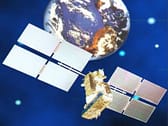 As of Friday Sept. 16, 2011, NASA’s Upper Atmosphere Research Satellite, or UARS, is expected to re-enter Earth’s atmosphere September 23, plus or minus a day. The re-entry of UARS is coming a day earlier than previously predicted because of a sharp increase in solar activity this week. Solar effects from the sun can create an extra drag on satellites in space because they can heat the Earth’s atmosphere, causing it to expand, agency officials have said.
As of Friday Sept. 16, 2011, NASA’s Upper Atmosphere Research Satellite, or UARS, is expected to re-enter Earth’s atmosphere September 23, plus or minus a day. The re-entry of UARS is coming a day earlier than previously predicted because of a sharp increase in solar activity this week. Solar effects from the sun can create an extra drag on satellites in space because they can heat the Earth’s atmosphere, causing it to expand, agency officials have said.
The exact date and geographic location of re-entry is hard to predict because it depends on solar activity and the satellite’s orientation as its orbit decays. As re-entry draws closer, predictions on the date will become more reliable. NASA is keeping a close watch on the falling satellite, but will only be able to pinpoint its actual crash zone to within about 6,000 miles (10,000 km) about two hours before re-entry.
Although the spacecraft will break into pieces during re-entry, not all of it will burn up in the atmosphere. NASA expects at least 26 large pieces of the massive satellite to survive the scorching temperatures of re-entry and reach Earth’s surface. Titanium pieces and onboard tanks could be among that debris, but the UARS satellite carries no toxic propellant.
NASA officials expect the UARS satellite to fall over a region somewhere between the latitudes of northern Canada and southern South America, which leaves a vast swath of the world open as a possible re-entry point. About 75 percent of the Earth’s surface is covered in water, which makes an ocean splashdown likely, NASA and experts have said.
The risk to public safety or property is extremely small, according to NASA’s website. There is a 1-in-3,200 chance of satellite debris hitting a person on the ground, odds that NASA says are extremely remote. Other experts agree. To date, there have been no confirmed reports of an injury or significant property damage resulting from re-entering space objects. Nor is there a record of significant property damage resulting from a satellite re-entry.
NASA’s UARS satellite was the first multi-instrumented satellite to observe numerous chemical constituents of the atmosphere with a goal of better understanding atmospheric photochemistry and transport. The defunct bus-size spacecraft was launched in 1991 and then shut down in 2005 after completing its mission.
NASA has advised the public that if you find something you think may be a piece of UARS, do not touch it. You should contact a local law enforcement official for assistance.
For more information, go to NASA’s UARS website.